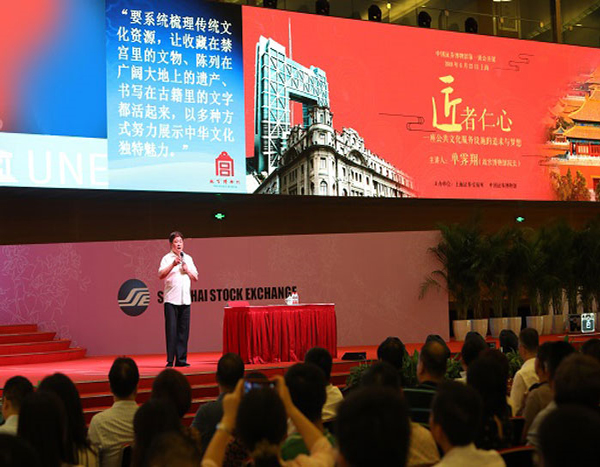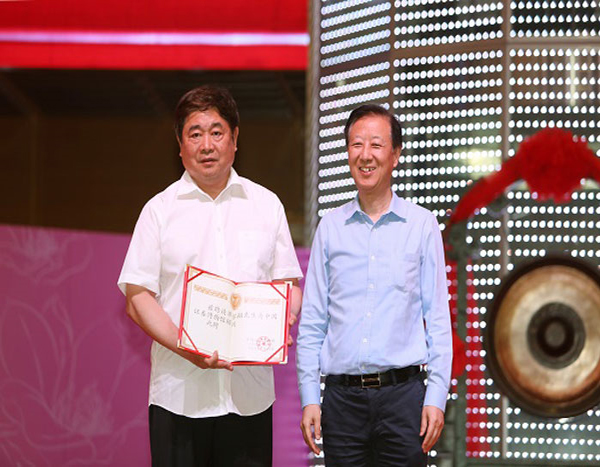On the evening of June 23, the first open lecture of the China Securities Museum (CSM) officially kicked off on the trading floor of the Shanghai Stock Exchange (SSE). Hosted by Jiang Yang, member of the 13th National Committee of the Chinese People's Political Consultative Conference (CPPCC), former vice chairman of the China Securities Regulatory Commission (CSRC) and chief of the leading group for preparatory work of the CSM, the open lecture was delivered by Shan Jixiang, director of the Palace Museum, and Jiang Feng, SSE deputy Party chief and president, gave a welcome speech. The trading floor was crowded with more than 300 representatives of the financial industry in Shanghai, who shared a cultural feast originating from the Forbidden City.

Director Shan Jixiang of the Palace Museum gives a lecture.
What image should a museum give the public? How should the interesting historical information be linked up with modern people's life? With the title "Masters' Hearts: the Pursuit and Dreams of the Palace Museum", Shan told the audience about the overall renovation, planning and reconstruction, restoration of cultural relics, digital management, cultural exchanges and other wonderful stories related to the Palace Museum in recent years. During more than two hours of soul-stirring lecture like floating clouds and flowing water, director Shan talked about millions of treasures in the Palace Museum's collection with great familiarity, sparking applause and laughter from time to time.
A museum needs humanistic care for those who approach her." Director Shan described a number of improvement measures taken by the Palace Museum such as adding rest seats, carrying out the “toilet revolution”, using the high-tech lighting to “light up” the centuries-old halls, removing temporary buildings, improving the guide signs and achieving the goal of no litter on the ground. Shan said that the museum is not only an important carrier condensing the Chinese culture and a significant witness for recording the Chinese civilization, but also an essential source for carrying forward the spirit of the Chinese nation. "To pass on a magnificent Forbidden City to the next generation is the mission and responsibility of every staff member in the Palace Museum."
“The biggest challenge for a museum is how to serve every visitor.” According to Shan, as the world's top museum in terms of the number of the visitors received each year, the Palace Museum recorded more than 16 million tourists last year, far more than 8 million people registered by French Louvre ranking the second. How should we solve the dilemma between the number of the visitors and the visiting quality? In this regard, the Palace Museum introduced the "peak balance" measures such as making adjustments in peak and off-peak periods, limiting the number of visitors every day and dividing visitor flows in different hours, and implemented the online tickets booking in an all-round way. With a year and a half of hard work, the number of the visitors has been restricted within 80,000 every day, and realized time-division visiting, which not only meets the demand of the visitors but also ensure the visiting quality.
“Being an open museum” was the information repeatedly mentioned in the lecture. “Restoring cultural relics is a process of public promotion. We must let the public know what attitudes and techniques we adopt in repairing cultural relics in the Forbidden City, so that the public can enjoy the rights to know, participate, supervise, and share benefit.” In order to comprehensively restore the collections of cultural relics, the Palace Museum has established the world's first Cultural Relics Hospital of Palace Museum, with the world's top scientists gathered and the volunteers recruited in an open manner to make scientific diagnosis and customized renovation plans for the cultural relics collected in the museum. Today, the Palace Museum has opened 80% of its area to the public, and will open more in the future, so as to continue to bring more pleasant surprises to the visitors. “The real openness is to put the cultural relics into the public's view, so that the whole society can better understand the Palace Museum and the Chinese culture, as well as jointly participate in the protection of the Palace Museum."
How did the Palace Museum turn millions of offline visitors into hundreds of millions of online viewers? According to statistics, the official website of the Palace Museum recorded 891 million page views last year, and more than 1.8 million pieces of collections have been all exhibited online. According to director Shan, the digital techniques and online interaction communities such as the Duan Gate Digital Museum, digital carpets, digital calligraphy, digital paintings, digital scrolls, digital screens, digital weaving embroidery, digital Hall of Mental Cultivation, digital imperial catering room, VR virtual theater and the Forbidden City community have turned the huge cultural treasure house of the palace into a “Digital Palace Museum” that is accessible and vivid to the common people. “We have launched a number of APPs. The “Painting of Han Xizai's Evening Banquet APP”, for example, contains 220 points of knowledge that can bring every visitor touching the APP back to the long river of history. The APP of "Daily Forbidden City" pushes the knowledge of the collections every day, which enables the viewers to create a hand-held Palace Museum of their own.” In his lecture, director Shan talked about the wonderful digital programs, the cultural creative products full of new ideas, the training bases at home and abroad and the international cultural exchanges across different eras and regions, which made the audience full of expectation for the future of the Palace Museum.
Jiang Yang said in his summary that the preparation for the establishment of the CSM aims not only to showcase the achievements in China's reform and opening up as well as development of the capital market, but also to record, pass on and popularize the financial and securities knowledge and culture, and it is also a social responsibility that museums are supposed to undertake. "We should shoulder the responsibility of spreading Chinese culture and bear in mind the mission of serving the visitors. It is also the principle we should stick to when managing the CSM well."

Jiang Yang (right), chief of the leading group for preparatory work of the China Securities Museum, issued a letter of appointment to Shan Jixiang (left), director of the Palace Museum.
In order to build the CSM into a state museum at the international level and receive more comprehensive and professional guidance, the leading group for preparatory work of the CSM decided to employ Shan as a consultant to the CSM. Jiang Yang issued a letter of appointment to Shan.
The open lecture also marked another important stage characterized by the comprehensive advancement and gradual implementation of the preparatory work for the CSM. In the near future, the CSM will be officially opened to the public, so as to demonstrate to the public the fruitful results in the development of China's capital market and create a highland for securities and futures culture that highlights the “Confidence in Four Aspects” (i.e., the socialist road with Chinese characteristics, theory, system and culture) of China's capital market.




